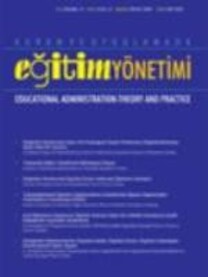Örgütsel Mutluluk Ölçeğinin Türkçeye Uyarlanması
Adaptation of Well-Being at Work Scale to Turkish
___
- Bakker, A. B., & Demerouti, E. (2013). La teora de las demandas y los recursos laborales. Revista de Psicologa del Trabajo y de las Organizaciones, 29(3), 107-115.
- Begum, S., Jabeen, S., & Awan, A. B. (2014). Happiness: A psychophilosophical appraisal. Dialogue, 9(3), 314.
- Brief, A. P., & Weiss, H. M (2002). Organizational behavior: affect in the workplace. Annual Review of Psychology, 53, 279-307.
- Büyüköztürk, S. (2007). Sosyal bilimler için veri analizi el kitabı. Ankara: Pegem Akademi.
- Cropanzano, R., & Wright, T. A. (1999). A 5-year study of change in the relationship between well-being and job performance. Consulting Psychology Journal, 51, 252-265.
- Çelik, H. E., & Yılmaz, V. (2013). LİSREL 9.1 ile yapısal eşitlik modellemesi. Ankara: Anı.
- Daniels, K. (2000). Measures of five aspects of affective well-being at work. Human Relations, 53(2), 275-294.
- Demo, G., & Paschoal, T. (2013). Well-Being at work scale: Exploratory and confirmatory validation in the United States comprising affective and cognitive components. Proceeding XXXVII Encontro da ANPAD, 7-11 September 2013. Rio de Janeiro.
- Diener, E. (2000). Subjective well-being. American Psychologist, 55, 34-43.
- Diener, E., Emmons, R. A., Larsen, R. J., & Griffin, S. (1985). The satisfaction with life scale. Journal of Personality Assessment, 49(1), 71-75.
- Easterlin, R. A. (2003). Explaining happiness. PNAS, 100(19), 11176–11183.
- Eğitim-İŞ, (2014). Öğretmenler mutsuz, borçlu ve öğretmenlik itibarsızlaştırılıyor. Retrieved from http://www.egitimis.org.tr/guncel/sendika-haberleri/ ogretmenler-mutsuzborclu-ve-ogretmenlik-itibarsizlastiriliyor-1458/#.WS 8zh2jyjIU
- Frey, B., & Stutzer, A. (2001). Happiness and economics: How the economy and institutions affect human well-being. New Jersey: Princeton University. Gavin, J. H., & Mason, R. O. (2004). Organizational Dynamics, 33(4), 379-392.
- Golparvar, M., & Abedini, H. (2014). Relationship between meaning and spirituality at work with job happiness positive affect and job satisfaction. Management Science Letters, 4, 255-268.
- Helliwell, J., Layard, R., & Sachs, J. (Eds.). (2017). World Happiness Report 2017. New York: Sustainable Development Solutions Network.
- Kashdan, T. B., Biswas-Diener, R., & King, L. A. (2008). Reconsidering happiness: The costs of distinguishing between hedonics and eudaimonia. Journal of Positive Psychology, 3, 219-233.
- Kline, R. B. (2005). Principles and practice of structural equation modeling (2nd ed.). New York: Guilford.
- Lyubomirsky, S. (2001). Why are some people happier than others? The role of cognitive and motivational processes in well-being. American Psychologist, 56, 239-249.
- Paschoal, T., & Tamayo, A. (2008). Construção e validação da escala de bemestar no trabalho. Avaliação Psicológica, 7(1), 11-22.
- Saenghiran, N. (2013). Towards enhancing happiness at work: a case study. Social Research Reports, 25, 21-33.
- Seligman, M. C., & Csikszentmihalyi, M. (2000) Positive psychology: An introduction. American Psychologist, 55, 5-14. doi: 10.1037//0003- 066X.55.1.5
- Seligman, M. E. P. (2003). Authentic happiness, London: Nicholas Brealey. Stiglitz, J. E., Sen, A., & Fitoussi, J. P. (2009). Report by the commission on the Measurement of economic performance and social progress. Paris, France. Retrieved from http://www.stiglitzsen-fitoussi.fr/en/index.htm
- Sümer, N. (2000). Yapısal eşitlik modelleri. Türk Psikoloji Yazıları, 3(6), 49-74.
- Şimşek, Ö. (2007). Yapısal eşitlik modellemesine giriş: Temel ilkeler ve LİSREL uygulamaları. Ankara: Ekinoks.
- Türk Eğitim-SEN (2011). Öğretmenler mutsuz ve borçlu çıktı. Retrieved from http://www.haberturk.com/polemik/haber/690452-ogretmenler-mutsuz-ve borclu-cikti
- Warr, P. (2007). Work, happiness and unhappiness. New Jersey: Lawrence Erlbaum Associates.
- Waterman, A. S. (1993). Two conceptions of happiness: Contrasts of personal expressiveness (eudaimonia) and hedonic enjoyment. Journal of Personality and Social Psychology, 64(4), 678-691.
- Waterman, A. S., Schwartz, S. J., & Conti, R. (2008). The implications of two conceptions of happiness (hedonic enjoyment and eudaimonia) for the understanding of intrinsic motivation. Journal of Happiness Studies, 9, 41- 79.
- Watson, D., Clark, L. A., & Tellegen, A. (1988). Development and validation of brief measures of positive and negative affect: The PANAS scales. Journal of Personality and Social Psychology, 54(6), 1063-1070.
- ISSN: 1300-4832
- Yayın Aralığı: 4
- Başlangıç: 1995
- Yayıncı: Pegem Akademi Yayıncılık Eğitim Danışmanlık Hizmetleri Tic. Ltd. Şti.
Üniversite Öğrencilerinin Sosyal Medya Kullanım Amaçlarının İncelenmesi
İSMAİL ACUN, CEMİL YÜCEL, CÜNEYT BELENKUYU, SERAP KELEŞ
Okullarda Psikolojik Güvencesizliğin Bireysel ve Kurumsal Değişkenler Açısından İncelenmesi
ŞENYURT YENİPINAR, KAMİL YILDIRIM
Ortaöğretim Kurumlarında Örgüt Kültürü ile Yabancılaşma Arasındaki İlişkinin İncelenmesi
MEHMET KORKMAZ, Mehmet Sabir ÇEVİK
